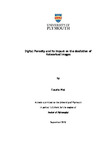Digital Porosity and Its Impact on the Mediation of Networked Images
| dc.contributor.supervisor | Wells, Liz | |
| dc.contributor.author | Pilsl, Claudia | |
| dc.contributor.other | Faculty of Arts, Humanities and Business | en_US |
| dc.date.accessioned | 2020-08-19T08:19:44Z | |
| dc.date.available | 2020-08-19T08:19:44Z | |
| dc.date.issued | 2020 | |
| dc.identifier | 10535874 | en_US |
| dc.identifier.uri | http://hdl.handle.net/10026.1/16175 | |
| dc.description.abstract |
This doctoral research examines digital porosity and how this effect of the Internet influences the mediation of networked images. This practice research is informed by the hypothesis that digital porosity affects the communication of data with it the perception of context and chronological order of events. Digital porosity, intended as a loose analogy to the kind of porosity depicted by Benjamin and Lacis (1925) in their description of everyday life in ‘Naples’, is a neologism that I devised to describe one of the consequences of the Internet since web 2.0. As the area afflicted by digital porosity is potentially large, I use my creative practice to investigate a specific aspect, that is, the interaction with the online photo-scape. The thesis focuses primarily on the following topics: disjunctions between time and space, gleaning and sharing images, copyright and mediation, and de-contextualization and affect and consists of a series of practice works that are generated through the engagement with on- and offline still and moving image material. The written explorations contextualizing these works comprise reflections on works by artists (Rachel Rose, Sylvia Grace Borda, Mishka Henner) who either deploy overtly online material or place their work on the Internet and evaluations of various theoretical discourses that address time, space, economy, mediation and virtuality. In particular, I draw on Bruno Latour’s and Emilie Hermant’s collaborative photo essay ‘Paris - Ville Invisible’, on Estelle Jussim’s writings on the eternal moment, and on David Harvey’s theory of time-space compression. Next to these core texts, I also consider various other critical positions as put forward by Sarah Kember and Joanna Zylinska, Brian Massumi, and Shoshana Zuboff. This inquiry offers insights into how digital porosity manipulates the mediation of data attached to networked images and also contributes to the understanding of some of the social and political implications of the Internet since web 2.0. | en_US |
| dc.language.iso | en | |
| dc.publisher | University of Plymouth | |
| dc.subject | Digital porosity | en_US |
| dc.subject | Networked Image | |
| dc.subject | Mediation | |
| dc.subject | Photography | |
| dc.subject.classification | PhD | en_US |
| dc.title | Digital Porosity and Its Impact on the Mediation of Networked Images | en_US |
| dc.type | Thesis | |
| plymouth.version | publishable | en_US |
| dc.identifier.doi | http://dx.doi.org/10.24382/1125 | |
| dc.rights.embargoperiod | No embargo | en_US |
| dc.type.qualification | Doctorate | en_US |
| rioxxterms.version | NA |
Files in this item
This item appears in the following Collection(s)
-
01 Research Theses Main Collection
Research Theses Main



